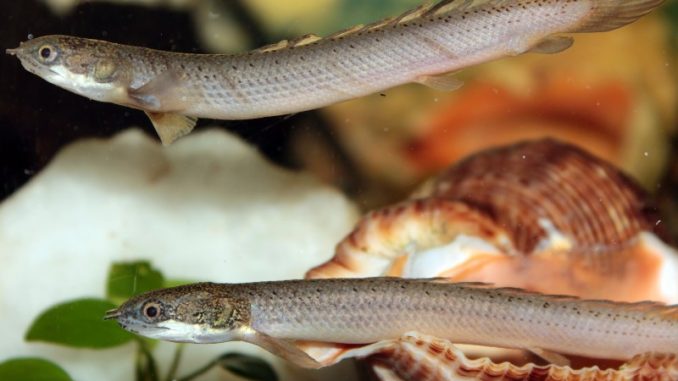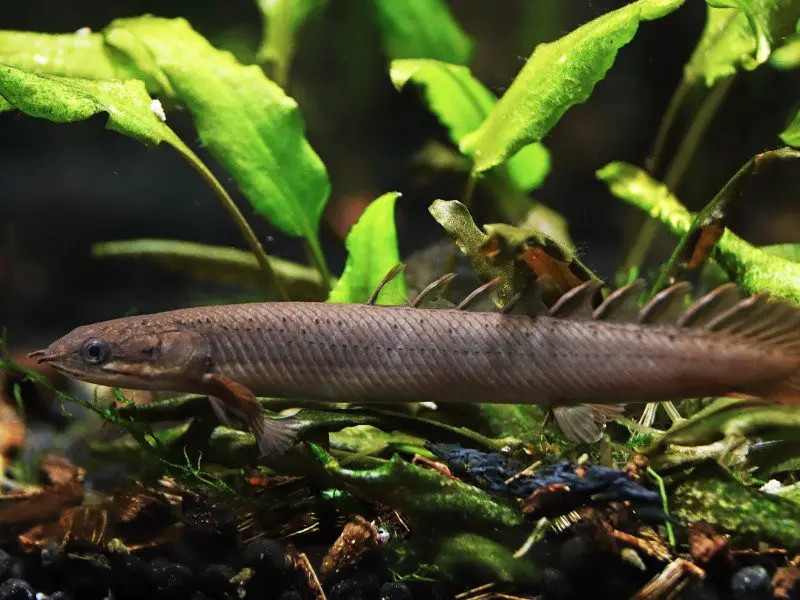
The dinosaur bichir, also known as the Senegal bichir, gray bichir, or dragon fish, is a freshwater fish of the Polypteridae family. Dinosaur bichirs have long, cylindrical bodies around one foot in length, and are gray or beige with subtle, splotchy patternings.
This fish’s protruding nostrils, strong scales, and serrated dorsal fin have been compared to a dragon, and the species has become popular among hobbyists.
While the dinosaur bichir can be overlooked by beginning aquarists due to its carnivorous feeding pattern, its graceful swimming and unique appearance are visually pleasing to aquarium keepers, and with proper care, the fish can live happily with other large tank mates for many years.
TABLE OF CONTENTS
Dinosaur Bichir Facts & Overview

| Scientific name | Polypterus senegalus |
| Common names | Senegal bichir, gray bichir, Cuvier's bichir, dinosaur eel, dinosaur bichir, dragon fish, swamp dragon |
| Distribution | Africa, India |
| Size | Up to 18 inches in captivity. 28 inches in the wild |
| Life expectancy | 10–15 years |
| Color | Gray or beige with occasional dark splotches |
| Diet | Carnivore |
| Temperament | Predatory |
| Minimum tank size | 29 gallons |
| Temperature | 77–80°F |
| pH | 6.5–7.5 |
| Hardness | 8–12 dGH |
| Care level | Intermediate |
| Breeding | Wild-caught |
Origin
In the wild, the dinosaur bichir is commonly found in the lakes, swamps, and floodplains of Africa and India. The dense vegetation and slow water movement in these environments allow this hardy fish to thrive, and in captivity, it needs a similar environment with good hiding places.
Adult Size & Lifespan
In captivity, the dinosaur bichir is significantly smaller than in the wild. Captive females typically reach 14 inches but can be as long as 18 inches, and males reach slightly shorter lengths. In the wild, this fish can extend up to 28 inches. Dinosaur bichir owners can expect the fish to live up to 15 years, making it a wonderful long-term aquarium dweller if well-cared for.
Availability
Hobbyists can easily find the dinosaur bichir in their local aquarium store. At a cost of around $10 for a small specimen, this fish is an affordable addition to any freshwater tank. The fish can also be found online on PetSmart, LiveAquaria, and Worldwide Fish and Pets.
Appearance & Behavior
The dinosaur bichir’s unique, dragon-like looks and predatory nature may seem intimidating to a beginner aquarist. However, the fish’s slow, meandering swimming pace and predictable behaviors make this fish a great beginner-to-intermediate freshwater aquarium fish.
Colors, Patterns, Fins, and Sex Differences
Most dinosaur bichirs are gray, beige, or brown with an irregular pattern of large dark brown or black splotches. Like eels, dinosaur bichirs are long and cylindrical, but their skin is scaled and strong.
This species’ head is round and smooth, and two pectoral fins are positioned behind and below the gill area. These fins provide most locomotion, while a serrated dorsal fin of 8–11 spines runs along the back leading to a flat, pointed caudal fin.
Juvenile specimens have gills that disappear with age, and some have a dark stripe pattern that fades as the fish ages. Male dinosaur bichirs grow to a slightly smaller size than females and possess a larger anal fin for reproductive purposes.
Typical Behavior
The dinosaur bichir is carnivorous and attempts to eat any fish it deems as prey — normally anything under 3 inches. The dinosaur bichir cohabitates with larger non-prey fish.
This fish uses its protruding nostrils to seek out prey, as its vision is weak, and it slowly paces around the tank with its pectoral fins, creating a graceful appearance as it explores. This bichir is also known to periodically dart to the top of the tank, using a set of primitive lungs to take gulps of air from the surface. At night or in the dark, it rests at the bottom of the tank, using suction to feed on crustaceans, worms, prey fish, or other carnivorous fish.
Dinosaur Bichir Care & Tank Requirements

Caring for a dinosaur bichir is relatively simple, despite its exotic looks. This fish enjoys a lush vegetative tank and feeds on crustaceans, worms, fish pellets, and flakes. Food doesn’t need to be alive, and the fish isn’t a picky eater — it’ll try to eat anything it can swallow.
Tankmates for a dinosaur bichir should be large, bold species, otherwise, the tank mate will be eaten or injured by the dinosaur bichir.
Habitat and Tank Requirements
While the dinosaur bichir isn’t particularly shy in its tank, this bottom-dweller requires some hiding spots and resting areas. Use an aquarium sand substrate as a base, adding smooth rocks and driftwood to create crevices and caves. Java fern and java moss add a great vegetative environment and give the fish areas to explore.
Shallow tanks allow optimal swimming and feeding, and a tightly sealed cover is a must because the dinosaur bichir will dart up to the surface rapidly to breathe air, and might escape. Loose aquarium hoods allow the fish to jump out of the tank.
Tank Conditions
The dinosaur bichir species requires a freshwater tank, and while it’s a sturdy fish, owners should ensure clean conditions.
Specific tank conditions include:
- Water type: Freshwater
- Tank size: Minimum 29 gallons
- Tank shape: Wide bottom surface area for feeding and resting
- Water temperature: 77–80°F (25–27°C)
- Substrate: Aquarium sand
- Tank setup: Smooth rocks, driftwood, dense vegetation
- Acidity: pH 6.5–7.5
- Water hardness: moderate, 8–12 dGH
- Filter: Recommended, to reduce manual cleaning of feces
- Bubbler: Not necessary. The bichir naturally surfaces to breathe
Overall, this species has low maintenance needs and is a sturdy, strong species for new aquarists to keep.
Disease
One benefit of keeping a dinosaur bichir is the fish’s resistance to disease. This breed isn’t susceptible to any particular illness, making it resilient and easy to care for. However, owners should note that wild-caught specimens often carry a parasite, Macrogyrodactylus polypteri, which kills tank mates. A quarantine aquarium or transfer salt bath are simple solutions to this problem.
Tank Mates
Despite its carnivorous nature, the dinosaur bichir is peaceful in tanks among other large fish. As long as the tank mate is greater than half the bichir’s size, or at least 3 inches long, the potential for co-living is high.
Fantastic tank mates for dinosaur bichirs include:
- Other Polypterus specimens
- Bloch’s catfish (Pimelodus blochii)
- “Silver dollar” fish (Metynnis argenteus)
- Lesser spiny eel (Macrognathus aculeatus)
- Black acara (Cichlasoma bimaculatum)
- Bala shark (Balantiocheilos melanopterus)
Diet and Feeding

As a carnivorous bottom feeder, the dinosaur bichir eats crustaceans, small fish, aquatic insects, and amphibians in the wild. In captivity, this species isn’t selective and enjoys a wide variety of foods including earthworms, shrimp, mussels, feeder fish, or dried pellets and flakes.
Feed the fish once daily, and, to avoid dirtying the tank with food waste, only provide enough food for two to three minutes of feeding. Dinosaur bichirs prefer to feed in the dark, and use their nostrils to seek out food on the bottom of the tank.
Breeding
The dinosaur bichir is often wild-caught, but this species can breed in aquariums as well. Encourage breeding in an aquarium by providing an excellent living environment to foster courtship, including high-quality water with frequent changes, a varied selection of live food, and a sizable tank with suitable vegetation for egg-laying.
Courtship and breeding occur during the rainy season in the wild and can be simulated in the tank by replacing water with a colder temperature of 60.8–69.8ºF (16–21ºC). During courtship, the female deposits 100–300 eggs over several days, which are fertilized by the male and then deposited among plants in the tank.
After courtship and egg fertilization occur, transfer the plants or breeding partners to a new tank so the adults don’t eat the eggs. Bichir fry feed on their egg sacs for a week after birth, and owners can begin to feed them small live shrimp, worms, or mosquito larvae after one week. Remove larger fry as needed to avoid cannibalism.
Should You Get a Dinosaur Bichir for Your Aquarium?
Some beginner aquarists are intimidated by the dinosaur bichir’s carnivorous diet and aggression in captivity. However, potential owners should not be driven away by these unique traits.
This species’ soothing swimming pattern, flexible diet, and dragon-like appearance make it a highly appealing addition to a freshwater aquarium. With dedication and a healthy tank environment, the dinosaur bichir is a versatile, long-living, and fascinating freshwater species to own.

Hi Robert, How are you, I have to catfish in my tank approximately 8cms. If I send you some pictures of them could you tell me the sex of them, I have tried but can’t figure it out. Thankyou, kind regards, Simone scholte.